Sugar is a Female
© Thomas Wilson Shawcross 15 Oct 2006


The ambience of The Cuban Café is enhanced by its splendid art collection. Shown here are its two largest prints, which are by Vintage Travel Poster artist Kerne Erickson.
Last week, I was riding shotgun on the end stool by the window at The Cuban Café in Pompano Beach. I was idly nibbling on the potato sticks that had fallen onto my plate off of my steak sandwich, and downing the last sips from my can of Ironbeer. My luncheon companion, friend, and work colleague, Robert Lobaina, was conversing in Spanish with a lady who worked behind the counter.
I started thinking about how much I liked this place, and how I should properly thank my friend and work colleague Lynn Massenzio for tipping me off about this small eatery. Small is, I think, the correct word, as the café does not have room enough for tables and chairs. It consists of seven stools in front of an L-shaped counter, with four additional stools in what could generously be called an adjoining nook area.
As usual, it was standing-room-only at The Cuban Café. The atmosphere was thick with the pleasant aromas of espresso, platanos maduros, ham, pork, white rice, and black beans. It was also thick with non-stop Spanish chatter by the standing patrons, mostly local industrial workers, who were waiting for their take-out orders.
I understood almost nothing of what they were saying, since spoken Spanish is mostly Greek to me. Having attempted for the past two years to assist my son Michael with his Spanish language studies, I have developed a minimal ability to read Spanish, but since I never sat in the classroom with him and heard how the words were supposed to be pronounced, I tend to pronounce Spanish words as if they were French (the only language besides English in which I have some fluency). Perhaps the best way to describe my level of proficiency in Spanish is to say that I speak enough Spanish to be misunderstood.
I finished my Ironbeer and started wondering how to describe its unique flavor. Somewhere, I had read a description that pegged it as a “citrusy root beer,” but I find no taste similarity between root beer and ironbeer. Perhaps the text on the can itself would provide a clue? No, it said only “On a summers afternoon, in 1917 a mule-drawn, wooden wagon arrived at a popular cafeteria in Havana, Cuba. It delivered the first four cases of a new soft drink that would soon be called "The National Beverage". Now more than 80 years later, IRONBEER is still enjoyed for its refreshing flavor with just a hint of island spices. A lot can change over the years - but not the original flavor of IRONBEER!”
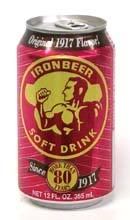
No, if I were writing the can copy, I would describe it as “an impudent, fruit-punch-flavored soft drink, with hints of Brazilian guarana berry and top notes of Bazooka bubble gum.”
As Robert and the waitress continued to converse in Spanish, I decided to surprise Robert (and the waitress, and no doubt everyone else in the café) by unleashing my best Spanglish and ordering a Cuban coffee. My Spanglish (a dialect in which one uses Spanish for the easy words and English for the hard words) was more than a little rusty (since Michael isn’t taking Spanish this year), so I decided to rehearse a bit. Softly, I muttered “Yo quiero dos cafes Cubanos (one for me and one for Robert), con leche y un pico azucar.” (I would like two Cuban coffees, with milk and a little sugar.) But, no, that didn’t seem quite right. Maybe it should be “Quisiera el café Cubano con leche y un pico azucar?”
But was “un pico” correct? That didn’t sound quite right, maybe it was “un poco?”
I must have said “un pico” a little louder than I intended, because the waitress paused in her conversation with Robert, looked at me earnestly, and said,
“Un azúcar pequeña, not un azúcar pequeño. Sugar is a female.”
Then we stared wordlessly at each other across a linguistic crossroad. I appreciated that she was trying to help me. Her Spanglish was better than mine. But we had both reached our limits. Suddenly, I felt like I had when I was six years old, when a bad case of laryngitis had caused me to stay at home and miss a day of first grade at Concord School. I was very thirsty but too short to reach the water faucet in the sink. I decided to impress Mom by handing her a note that said “Mom, would you please give me a glass of water?”
The only flaw to this plan was that I didn’t know how to spell most of the words in that sentence. I had only recently learned how to read, and I don’t believe I had as yet had any spelling lessons. I began my note well enough by printing “Mom,” but then I realized I had no idea of how to spell “would.” Well, ok then, I would use a homonym for “wood,” but before I could finish congratulating myself on my resourcefulness (we had not yet invented the phrase “thinking out of the box,”) I realized I didn’t know how to spell “wood” either. But I did not want to give up on my dream of impressing Mom with a hand-written note, so I decided I would simply draw a picture of a piece of wood. But how does one draw a piece of wood? Maybe I could just draw a twig, and Mom would figure out that I meant wood? Yes, Mom was pretty clever.
Unfortunately, my twig looked more like a thick horizontal line than a twig. The rational observer might have concluded I was trying to cross out a word, rather than depict one. Mom couldn’t figure out that my thick horizontal line was part of a rebus that meant “would.” I was really thirsty. Finally, in desperation, I pointed to the water faucet and then to my mouth. That worked, but I certainly felt foolish. Oddly, it had never bothered me when I watched Red Skelton on television but I could not understand many of the words in his comedy sketches. I knew Red was using English words that I had not yet learned, and I was satisfied with parsing out the words I did know, and anyway much of his comedy was physical humor.
But now it was 2006, not 1952, and Robert and the waitress were using Spanish words that I did not know, and not much, if any, physical humor was involved.
“Sugar is a female?” What were we talking about now? Suddenly, it dawned on me that Robert had been ordering two Cuban coffees for us, and he had been explaining to the waitress how much sugar should be involved. She must have thought that I understood more of the conversation than I had. I was flattered.
Afterwards, as we sat at the counter and drank our Cuban coffees (with milk and a little sugar), Robert and I discussed languages and their usages of grammatical genders/noun classes. For Americans who speak only English, it seems unusual to refer to objects that have no genital organs as being either male or female. The concept itself can even be a bit humorous.
The next day, my daughter Lauren Shawcross called me, and I related this story to her. Lauren is in her junior year at Emory University. Lauren speaks English, French, Spanish, and un poco Russian. Lauren informed me that “most of the Indo-European languages have grammatical genders/noun classes, Dad.”
Conversations such as this with Lauren always give me pause, because I can still remember her as a baby to whom I tried to introduce the concept that solid food (such as bits of chocolate-chip cookie) was, in fact, edible. Now, she has left me in the intellectual dust and explains things to me, such as (last week) Kant’s Analysis of Judgment, or, as in this case, how languages work.
Going on, Lauren noted that Old English had grammatical genders/noun classes, but that modern English has only “a vestigial natural gender system (on pronouns) but no grammatical gender.” Hence, in English, we might say something like “that is his chair,” or “that is her chair,” while chairs themselves are thought of in a gender fashion (if at all) as being neuter. Oh, we do sometimes use different word forms to indicate gender, such as actor or actress, but then we are in fact referring to objects that have a gender based on their physical possession of genital organs.
As such, English has more in common as a language with Chinese, Japanese, or even Basque, than it does with German, Hindi, Italian, Punjabi, Spanish, French, or even Klingon. Those languages have grammatical genders/noun classes.
Lauren continued, saying, “In Spanish, sugar is a female, but in French, sugar is a male.”
Whoa! Who knew? How does one decide such things, anyway?
I decided to go back to the Cuban Café and think about this while I enjoyed another Café Cubano with perhaps a side dish of flan.
Entering the café, I thought of how my knowledge of Cuban cuisine had been greatly expanded from the simple Cuban sandwich (sweet ham, smoked ham, pork, cheese, pickle, mayo and mustard, toasted and served on Cuban bread). Now, I felt equally at home in ordering a Midnight (Media Noche) sandwich, which is a basically the same thing as a Cuban sandwich, but served on toasted sweet yellow bread.
Also, I no longer thought, as I did when Robert first ordered a steak sandwich, that someone had spilled a can of potato sticks onto his sandwich. Well, such accidents do happen. The world-famous St. Louis Toasted Raviolis were invented when someone accidentally spilled some raviolis into a deep fryer and decided to serve them to the bar patrons rather than throw them out. When people started asking for more of these “toasted” raviolis, they became a permanent addition to St. Louis Italian restaurant/bar cuisine. Maybe I had just witnessed the invention of a new sandwich?
No, Robert patiently explained, one always puts potato sticks on steak sandwiches. Again, who knew? I would never have thought of doing that, but it is an excellent idea!
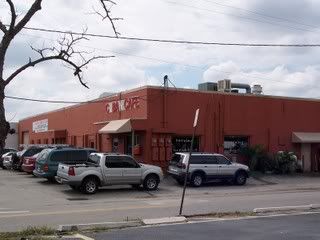
The Cuban Café, located at 1699 N. Powerline Road in Pompano Beach, FL
As I waited for my café Cubano and side dish of flan, I enjoyed looking at the The Cuban Café’s fabulous art collection. I have already mentioned the Kerne Erickson vintage travel posters, which are the crown jewels of an eclectic collection of product advertisements (mostly for Pilon coffee), photos of 1940’s-vintage American cars in modern-day Cuba, and a series of Cuban landscape photos, including one of Baracoa, which is Robert’s home town (Robert left Baracoa at the age of six, in order to be with his parents, who were migrating to the US).
The photo behind me is particularly intriguing, because I cannot understand how it fits in with the overall Cuban theme. It is a photo of Bridal Veil Falls. I am not sure which one, as there are more than thirty waterfalls, world-wide, that are named Bridal Veil Falls (none of which are in Cuba). I have seen the one in Oregon. I think this photo is of the one in Yosemite National Park. It is flanked by Cuban and American flags. It puzzles me, and I am determined to figure it out some day.
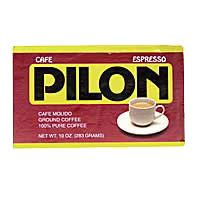
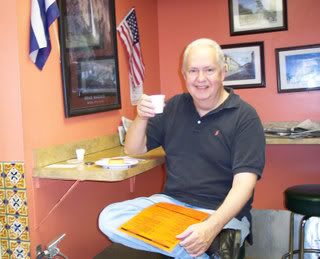
The author enjoys a Café Cubano and side dish of flan at The Cuban Cafe, which has a four-spigot espresso machine (no waiting) that cost (I have been informed by Robert Lobaina) $10,000!
Above is a photo of Tom Shawcross, who is sitting in “the nook” at The Cuban Café.
Below is a photo of a tile that is located in the restroom at The Cuban Café.
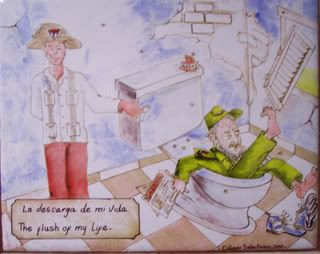
Anti-Castro sentiments rule at The Cuban Café
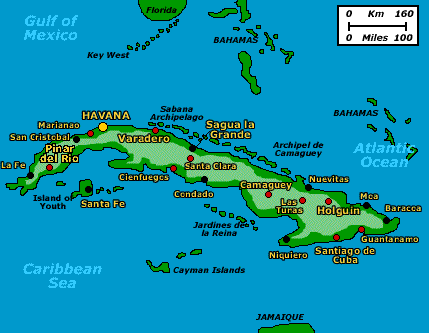
Baracoa, formerly in the Oriente Province, is Cuba’s eastern-most city
Since this has been a non-traditional story (with no discernible plot, or point, for that matter) – it is really just an excerpt from a couple of days in my life and some conversations and thoughts that I had – I will close it in a non-traditional way.
I wish I knew how to contact Kerne Erickson to ask for his permission to reproduce his work in my blog story, but I will make up for it by giving him some additional free publicity (after all, my blog has a reader as far away as Australia!).
Here are some more Kerne Erickson vintage travel posters, which can be purchased online:

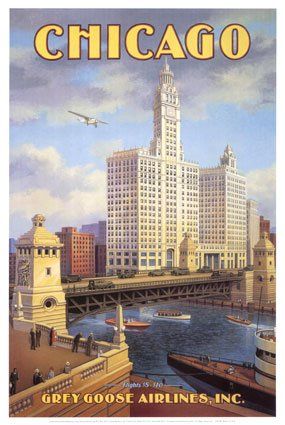
“Happy Trails and Buenas Noches!”
An original Spanglish phrase coined today by the author of this blog, Thomas Wilson Shawcross


The ambience of The Cuban Café is enhanced by its splendid art collection. Shown here are its two largest prints, which are by Vintage Travel Poster artist Kerne Erickson.
Last week, I was riding shotgun on the end stool by the window at The Cuban Café in Pompano Beach. I was idly nibbling on the potato sticks that had fallen onto my plate off of my steak sandwich, and downing the last sips from my can of Ironbeer. My luncheon companion, friend, and work colleague, Robert Lobaina, was conversing in Spanish with a lady who worked behind the counter.
I started thinking about how much I liked this place, and how I should properly thank my friend and work colleague Lynn Massenzio for tipping me off about this small eatery. Small is, I think, the correct word, as the café does not have room enough for tables and chairs. It consists of seven stools in front of an L-shaped counter, with four additional stools in what could generously be called an adjoining nook area.
As usual, it was standing-room-only at The Cuban Café. The atmosphere was thick with the pleasant aromas of espresso, platanos maduros, ham, pork, white rice, and black beans. It was also thick with non-stop Spanish chatter by the standing patrons, mostly local industrial workers, who were waiting for their take-out orders.
I understood almost nothing of what they were saying, since spoken Spanish is mostly Greek to me. Having attempted for the past two years to assist my son Michael with his Spanish language studies, I have developed a minimal ability to read Spanish, but since I never sat in the classroom with him and heard how the words were supposed to be pronounced, I tend to pronounce Spanish words as if they were French (the only language besides English in which I have some fluency). Perhaps the best way to describe my level of proficiency in Spanish is to say that I speak enough Spanish to be misunderstood.
I finished my Ironbeer and started wondering how to describe its unique flavor. Somewhere, I had read a description that pegged it as a “citrusy root beer,” but I find no taste similarity between root beer and ironbeer. Perhaps the text on the can itself would provide a clue? No, it said only “On a summers afternoon, in 1917 a mule-drawn, wooden wagon arrived at a popular cafeteria in Havana, Cuba. It delivered the first four cases of a new soft drink that would soon be called "The National Beverage". Now more than 80 years later, IRONBEER is still enjoyed for its refreshing flavor with just a hint of island spices. A lot can change over the years - but not the original flavor of IRONBEER!”

No, if I were writing the can copy, I would describe it as “an impudent, fruit-punch-flavored soft drink, with hints of Brazilian guarana berry and top notes of Bazooka bubble gum.”
As Robert and the waitress continued to converse in Spanish, I decided to surprise Robert (and the waitress, and no doubt everyone else in the café) by unleashing my best Spanglish and ordering a Cuban coffee. My Spanglish (a dialect in which one uses Spanish for the easy words and English for the hard words) was more than a little rusty (since Michael isn’t taking Spanish this year), so I decided to rehearse a bit. Softly, I muttered “Yo quiero dos cafes Cubanos (one for me and one for Robert), con leche y un pico azucar.” (I would like two Cuban coffees, with milk and a little sugar.) But, no, that didn’t seem quite right. Maybe it should be “Quisiera el café Cubano con leche y un pico azucar?”
But was “un pico” correct? That didn’t sound quite right, maybe it was “un poco?”
I must have said “un pico” a little louder than I intended, because the waitress paused in her conversation with Robert, looked at me earnestly, and said,
“Un azúcar pequeña, not un azúcar pequeño. Sugar is a female.”
Then we stared wordlessly at each other across a linguistic crossroad. I appreciated that she was trying to help me. Her Spanglish was better than mine. But we had both reached our limits. Suddenly, I felt like I had when I was six years old, when a bad case of laryngitis had caused me to stay at home and miss a day of first grade at Concord School. I was very thirsty but too short to reach the water faucet in the sink. I decided to impress Mom by handing her a note that said “Mom, would you please give me a glass of water?”
The only flaw to this plan was that I didn’t know how to spell most of the words in that sentence. I had only recently learned how to read, and I don’t believe I had as yet had any spelling lessons. I began my note well enough by printing “Mom,” but then I realized I had no idea of how to spell “would.” Well, ok then, I would use a homonym for “wood,” but before I could finish congratulating myself on my resourcefulness (we had not yet invented the phrase “thinking out of the box,”) I realized I didn’t know how to spell “wood” either. But I did not want to give up on my dream of impressing Mom with a hand-written note, so I decided I would simply draw a picture of a piece of wood. But how does one draw a piece of wood? Maybe I could just draw a twig, and Mom would figure out that I meant wood? Yes, Mom was pretty clever.
Unfortunately, my twig looked more like a thick horizontal line than a twig. The rational observer might have concluded I was trying to cross out a word, rather than depict one. Mom couldn’t figure out that my thick horizontal line was part of a rebus that meant “would.” I was really thirsty. Finally, in desperation, I pointed to the water faucet and then to my mouth. That worked, but I certainly felt foolish. Oddly, it had never bothered me when I watched Red Skelton on television but I could not understand many of the words in his comedy sketches. I knew Red was using English words that I had not yet learned, and I was satisfied with parsing out the words I did know, and anyway much of his comedy was physical humor.
But now it was 2006, not 1952, and Robert and the waitress were using Spanish words that I did not know, and not much, if any, physical humor was involved.
“Sugar is a female?” What were we talking about now? Suddenly, it dawned on me that Robert had been ordering two Cuban coffees for us, and he had been explaining to the waitress how much sugar should be involved. She must have thought that I understood more of the conversation than I had. I was flattered.
Afterwards, as we sat at the counter and drank our Cuban coffees (with milk and a little sugar), Robert and I discussed languages and their usages of grammatical genders/noun classes. For Americans who speak only English, it seems unusual to refer to objects that have no genital organs as being either male or female. The concept itself can even be a bit humorous.
The next day, my daughter Lauren Shawcross called me, and I related this story to her. Lauren is in her junior year at Emory University. Lauren speaks English, French, Spanish, and un poco Russian. Lauren informed me that “most of the Indo-European languages have grammatical genders/noun classes, Dad.”
Conversations such as this with Lauren always give me pause, because I can still remember her as a baby to whom I tried to introduce the concept that solid food (such as bits of chocolate-chip cookie) was, in fact, edible. Now, she has left me in the intellectual dust and explains things to me, such as (last week) Kant’s Analysis of Judgment, or, as in this case, how languages work.
Going on, Lauren noted that Old English had grammatical genders/noun classes, but that modern English has only “a vestigial natural gender system (on pronouns) but no grammatical gender.” Hence, in English, we might say something like “that is his chair,” or “that is her chair,” while chairs themselves are thought of in a gender fashion (if at all) as being neuter. Oh, we do sometimes use different word forms to indicate gender, such as actor or actress, but then we are in fact referring to objects that have a gender based on their physical possession of genital organs.
As such, English has more in common as a language with Chinese, Japanese, or even Basque, than it does with German, Hindi, Italian, Punjabi, Spanish, French, or even Klingon. Those languages have grammatical genders/noun classes.
Lauren continued, saying, “In Spanish, sugar is a female, but in French, sugar is a male.”
Whoa! Who knew? How does one decide such things, anyway?
I decided to go back to the Cuban Café and think about this while I enjoyed another Café Cubano with perhaps a side dish of flan.
Entering the café, I thought of how my knowledge of Cuban cuisine had been greatly expanded from the simple Cuban sandwich (sweet ham, smoked ham, pork, cheese, pickle, mayo and mustard, toasted and served on Cuban bread). Now, I felt equally at home in ordering a Midnight (Media Noche) sandwich, which is a basically the same thing as a Cuban sandwich, but served on toasted sweet yellow bread.
Also, I no longer thought, as I did when Robert first ordered a steak sandwich, that someone had spilled a can of potato sticks onto his sandwich. Well, such accidents do happen. The world-famous St. Louis Toasted Raviolis were invented when someone accidentally spilled some raviolis into a deep fryer and decided to serve them to the bar patrons rather than throw them out. When people started asking for more of these “toasted” raviolis, they became a permanent addition to St. Louis Italian restaurant/bar cuisine. Maybe I had just witnessed the invention of a new sandwich?
No, Robert patiently explained, one always puts potato sticks on steak sandwiches. Again, who knew? I would never have thought of doing that, but it is an excellent idea!

The Cuban Café, located at 1699 N. Powerline Road in Pompano Beach, FL
As I waited for my café Cubano and side dish of flan, I enjoyed looking at the The Cuban Café’s fabulous art collection. I have already mentioned the Kerne Erickson vintage travel posters, which are the crown jewels of an eclectic collection of product advertisements (mostly for Pilon coffee), photos of 1940’s-vintage American cars in modern-day Cuba, and a series of Cuban landscape photos, including one of Baracoa, which is Robert’s home town (Robert left Baracoa at the age of six, in order to be with his parents, who were migrating to the US).
The photo behind me is particularly intriguing, because I cannot understand how it fits in with the overall Cuban theme. It is a photo of Bridal Veil Falls. I am not sure which one, as there are more than thirty waterfalls, world-wide, that are named Bridal Veil Falls (none of which are in Cuba). I have seen the one in Oregon. I think this photo is of the one in Yosemite National Park. It is flanked by Cuban and American flags. It puzzles me, and I am determined to figure it out some day.


The author enjoys a Café Cubano and side dish of flan at The Cuban Cafe, which has a four-spigot espresso machine (no waiting) that cost (I have been informed by Robert Lobaina) $10,000!
Above is a photo of Tom Shawcross, who is sitting in “the nook” at The Cuban Café.
Below is a photo of a tile that is located in the restroom at The Cuban Café.

Anti-Castro sentiments rule at The Cuban Café

Baracoa, formerly in the Oriente Province, is Cuba’s eastern-most city
Since this has been a non-traditional story (with no discernible plot, or point, for that matter) – it is really just an excerpt from a couple of days in my life and some conversations and thoughts that I had – I will close it in a non-traditional way.
I wish I knew how to contact Kerne Erickson to ask for his permission to reproduce his work in my blog story, but I will make up for it by giving him some additional free publicity (after all, my blog has a reader as far away as Australia!).
Here are some more Kerne Erickson vintage travel posters, which can be purchased online:


“Happy Trails and Buenas Noches!”
An original Spanglish phrase coined today by the author of this blog, Thomas Wilson Shawcross


2 Comments:
wow I have been missing your blog! what great writing skills you have...I love reading your blog, very interesting.
I love the posters and can remember some of them, the TWA poster was popular when I applied to become a stewardess at TWA(didn't like flying) the Cuban ones inspired me to want to go to Cuba(I'm watching TCM a B/W movie where they are in Cuba...what fun the music and dancing!
You really should start writing again. You've got a very compelling way of telling a story about nothing and everything in particular.
Hope you consider taking up the practice again.
LMP
Post a Comment
<< Home